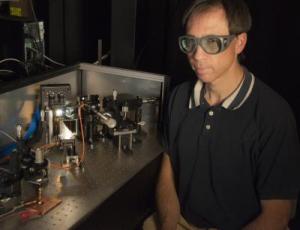May 31 2014
Researchers at the National Institute of Standards and Technology (NIST) have developed a laser-based instrument that generates artificial sunlight to help test solar cell properties and find ways to boost their efficiency.
 NIST engineer Tasshi Dennis is shown with NIST's solar simulator based on a white light laser. The instrument simulates sunlight to help measure the properties of solar cell materials. The instrument's beam is illuminating a gallium arsenide solar cell (yellow diamond) in the lower left corner of the photo. Credit: Burrus/NIST
NIST engineer Tasshi Dennis is shown with NIST's solar simulator based on a white light laser. The instrument simulates sunlight to help measure the properties of solar cell materials. The instrument's beam is illuminating a gallium arsenide solar cell (yellow diamond) in the lower left corner of the photo. Credit: Burrus/NIST
The novel NIST system simulates sunlight well across a broad spectrum of visible to infrared light. More flexible than conventional solar simulators such as xenon arc-lamps or light-emitting diodes, the laser instrument can be focused down to a small beam spot—with resolution approaching the theoretical limit—and shaped to match any desired spectral profile.
The new simulator is based on a white light laser that uses optical-fiber amplifier technology to boost the power and a photonic crystal fiber to broaden the spectrum. NIST researchers used the simulator to measure the efficiency of thin-film solar cells made of gallium-arsenide, crystalline silicon, amorphous silicon and copper-indium-gallium-selenide, and the results agreed with independent measurements.*
"We can focus the light down to a spot less than 2 micrometers in diameter, despite the wide spectral content. You can't do this with sunlight," NIST researcher Tasshi Dennis says. "We then used this focused spot to scan across solar cell materials while monitoring the current the light generated. This allowed us to create spatial maps (images) of the response of a solar cell at the micrometer level.
"The new instrument may help researchers understand solar cells' optical and electrical characteristics, including defects and the impact of unusual designs. In particular, the new simulator's capability to make rapid, accurate spectrum adjustments will help characterize the most efficient solar cells, which use multi-junction materials in which each junction is tuned to a different part of the spectrum. The instrument is designed to probe small research samples, individual concentrator solar cells and microstructures, not to determine the efficiencies of large solar cell panels and modules. NIST researchers have been working to make the new simulator programmable and portable for use outside NIST.
For more details see http://www.nist.gov/pml/div686/solar-simulator.cfm.
* T. Dennis, J.B. Schlager and K.A. Bertness. A novel solar simulator based on a super-continuum laser for solar cell device and materials characterization. IEEE Journal of Photovoltaics. Posted online May 26. DOI: 10.1109/JPHOTOV.2014.2321659.